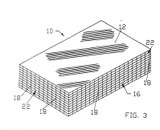
Louisville Bedding owns a patent on a mattress pad cover that uses a special skirt material. In its original suit against Pillowtex, Louisville got a negative claim construction and infringement opinion from the district court and the parties quickly settled. Shortly after settling, Pillowtex dissolved into bankruptcy.
After the earlier decision was used to collaterally estop Louisville in a later suit against another party, the patent holder filed a Rule 60(b)(6) motion to reopen (or vacate) the original decision. — The motion was denied, first by the district court and then affirmed on appeal.
The CAFC did not discuss whether the application of collateral estoppel of claim construction was correct. The appellate panel did, however, uphold the longstanding tradition of finality of judgment.
As the Supreme Court has recognized, "[p]ublic policy dictates that there be an end of litigation; that those who have contested an issue shall be bound by the result of the contest, and that matters once tried shall be considered forever settled as between the parties." Baldwin v. Traveling Men’s Ass’n, 283 U.S. 522, 525 (1931). This policy concern is even stronger when a case is ended by the deliberate choice of the parties.
Louisville Bedding argued that the changed circumstances of the Pillowtex bankruptcy opened the door to revisit the case. The CAFC disagreed.
Typically, a district court may grant relief under Rule 60(b)(6) only for "exceptional or extraordinary circumstances.” Louisville has not made such a showing. Because businesses fail every day, the failure of Pillowtex in this case, even though it appeared to be highly commercially successful in 1998, is not an "exceptional or extraordinary circumstance." To say the least, Louisville took a calculated risk that did not turn out the way that it expected. Nor can we say that the equities in this case particularly favor Louisville and its fateful business decision. In the Pillowtex case, Louisville was faced with a summary judgment of noninfringement and an unfavorable claim construction with respect to the ’322 patent. Its position looked bleak at that time. There was no certainty that Louisville could have had that result changed in the district court or on appeal if it did not enter into the settlement agreement. Thus, it was greatly to Louisville’s benefit to settle the case under the terms that it did.
Denial of R.60 motion affirmed.
I think the Federal Circuit got it right here. The process of collusive vacatur of opinions unfavorable to the party with an interest in future litigation is unseemly and bad public policy. Should patent owners be able to revive invalidated patents, merely by paying the victorious defendant to agree to undo the invalidation? If you don’t like a ruling, appeal. If you don’t want to risk having a ruling out there, settle first.
One possible way to avoid the collateral estoppel effect of an adverse claim construction order is to include in the settlement agreement a requirement that the trial court vacate the adverse order. While a defendant in a future infringement action might cite the vacated order and the trial judge might adopt it, an appeal could be taken from that order.
Comments are closed.